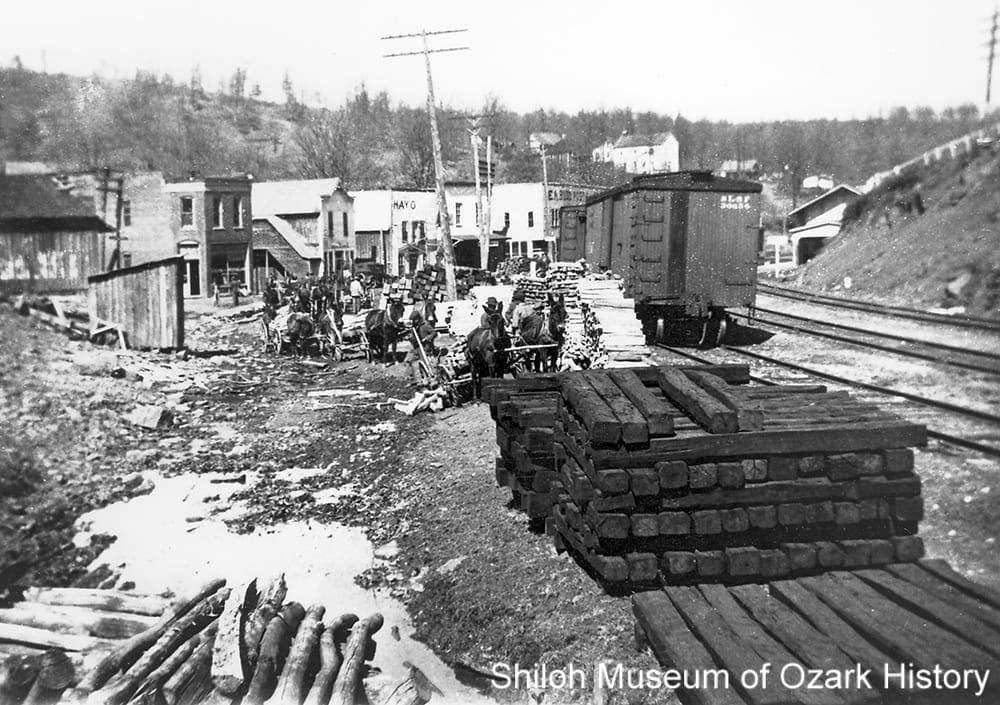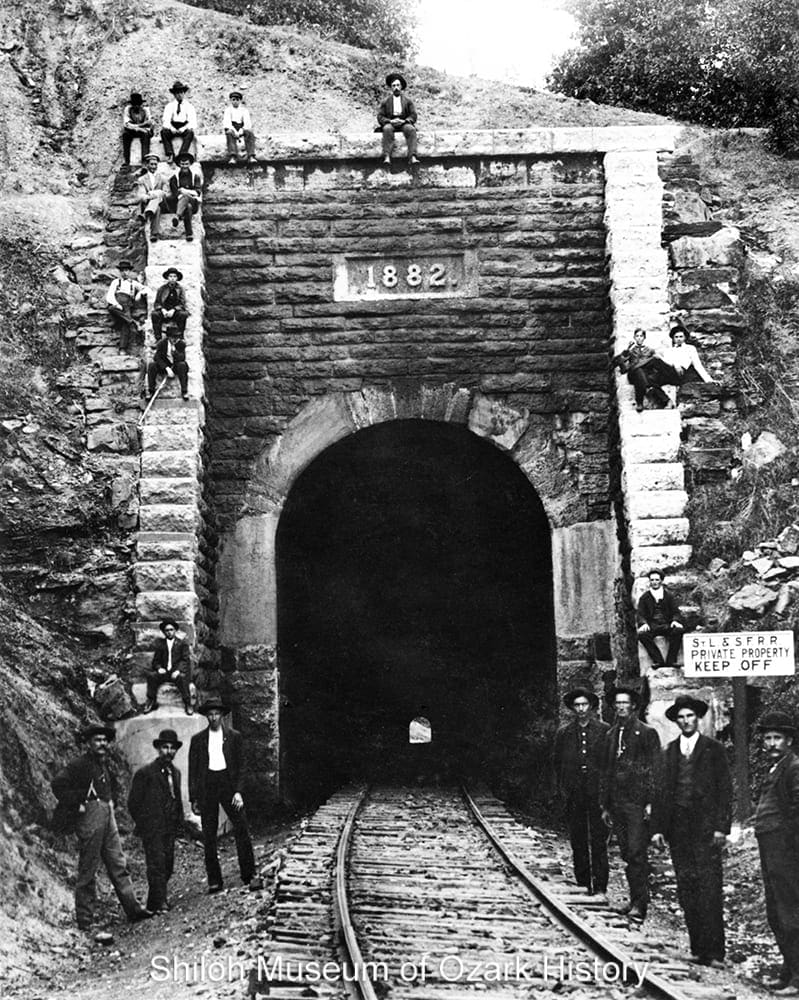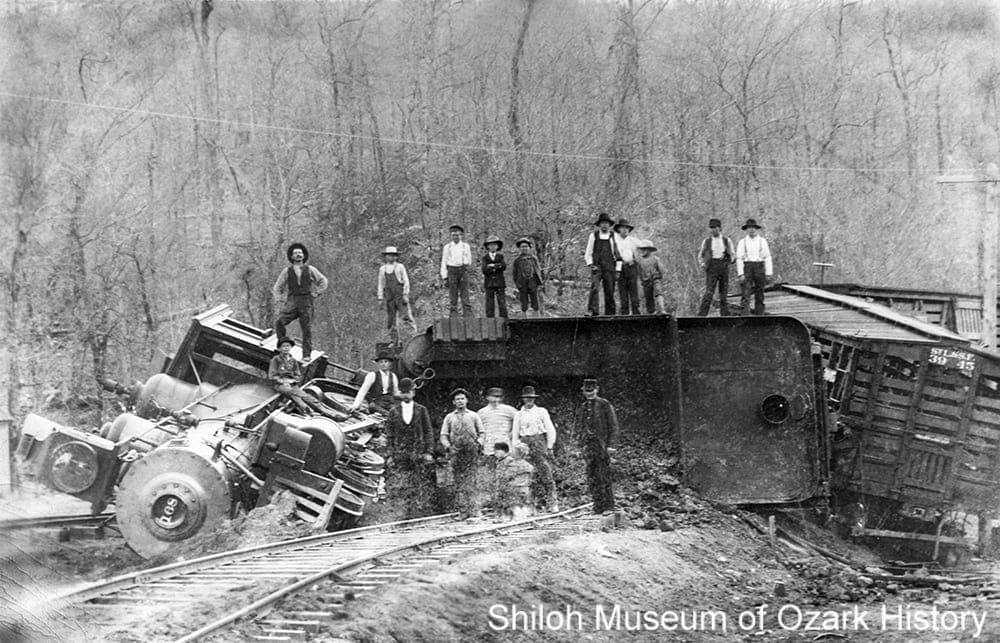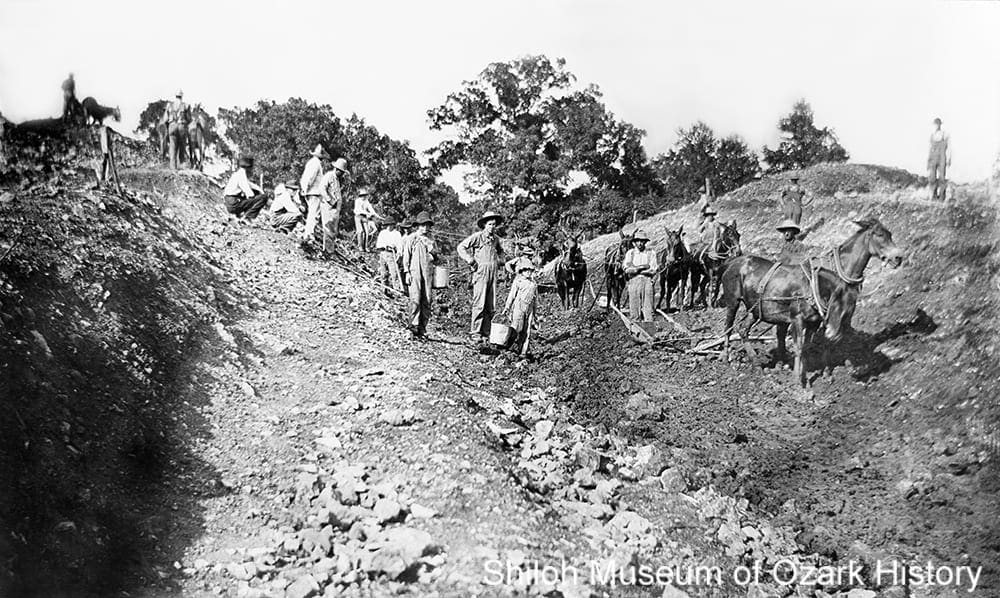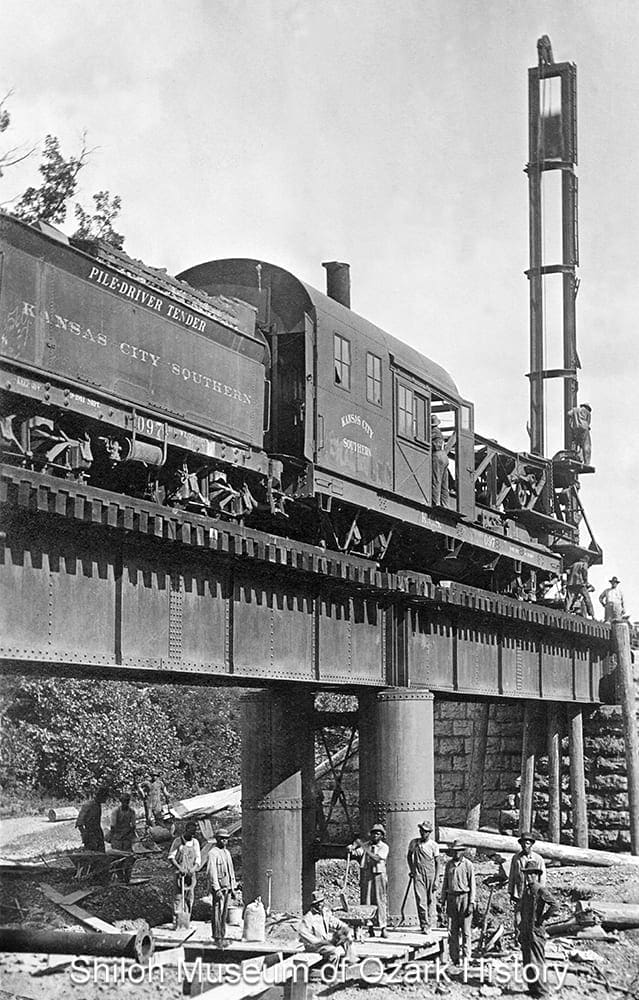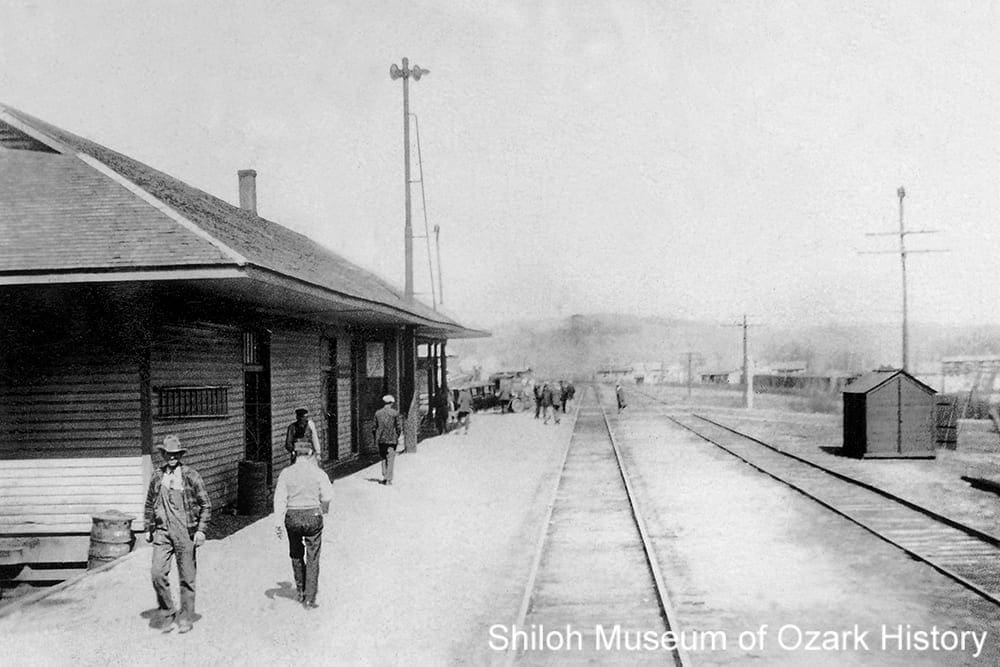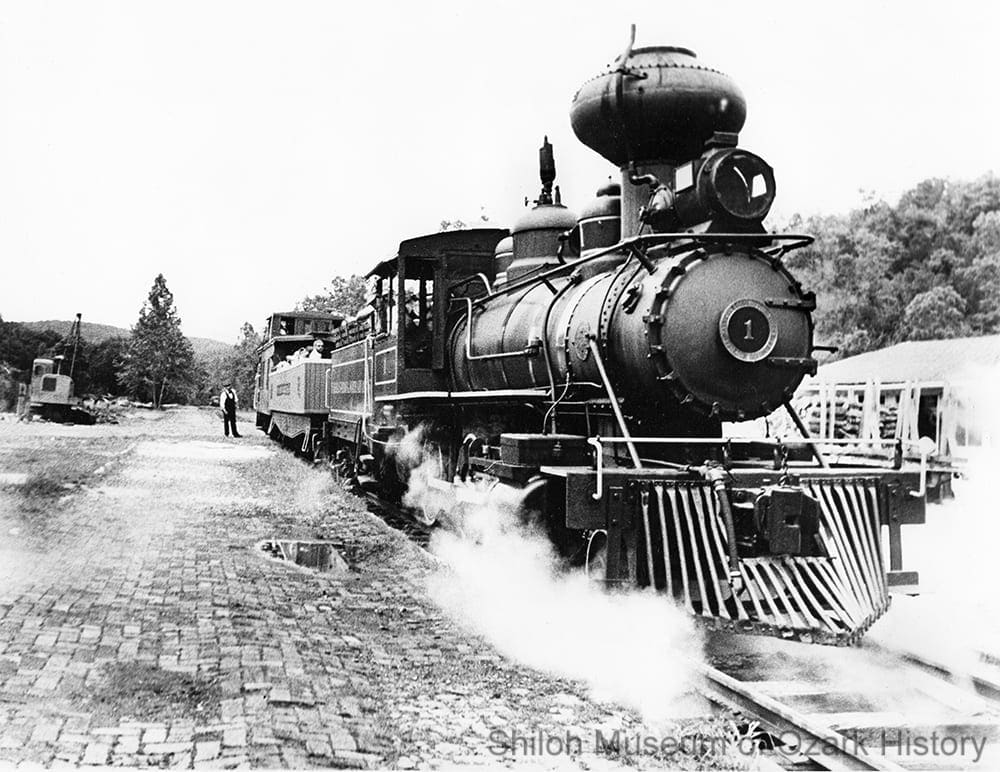Working on the Railroad
Online ExhibitThe Rise of Railroads
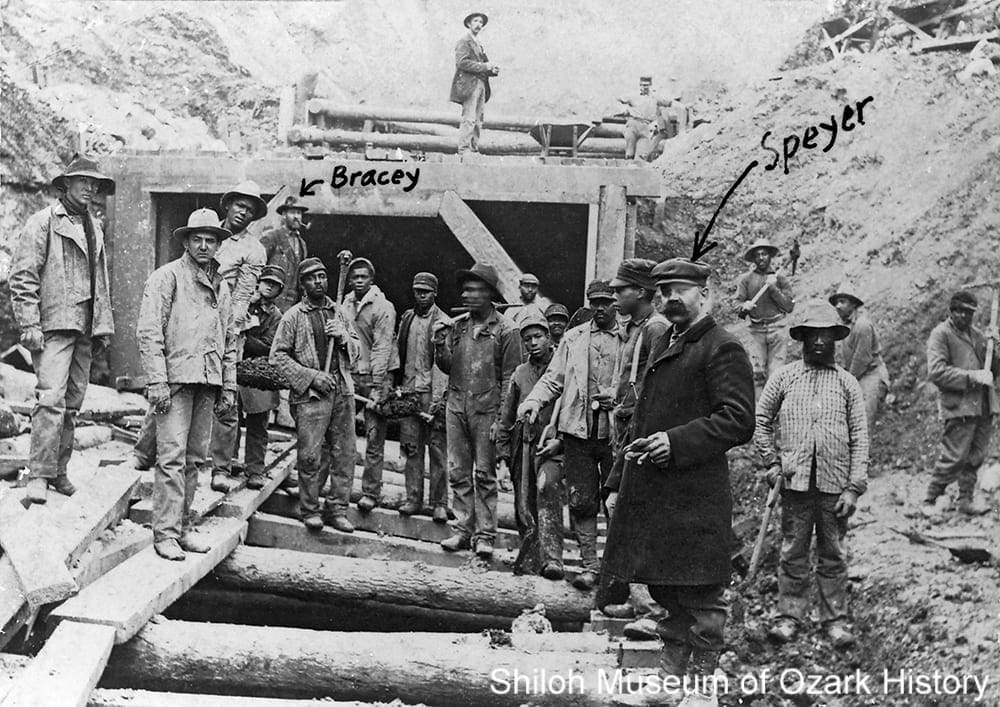
St. Louis & North Arkansas construction crew, Eureka Springs, 1901. Carroll County Heritage Center Collection (S-85-40-18)
The first railroad steamed into Northwest Arkansas in 1881, beginning a long era of growth and prosperity. Up until then, travel and the shipment of goods were limited to animal-drawn wagons lumbering along primitive dirt roads and paths. With the train came the opportunity to establish markets, develop industry and business, promote tourism, and increase population and financial health. Travel times improved. In 1908 the 31-mile trip between Rogers and Siloam Springs might take ninety minutes by rail as opposed to five or six hours by wagon, provided the train functioned properly. Passengers on the Arkansas, Oklahoma & Western used the railroad’s initials to form the nickname, the “All Off and Walk.”

St. Louis & North Arkansas construction crew, Eureka Springs, 1901. Carroll County Heritage Center Collection (S-85-40-18)
The Rise of Railroads
The first railroad steamed into Northwest Arkansas in 1881, beginning a long era of growth and prosperity. Up until then, travel and the shipment of goods were limited to animal-drawn wagons lumbering along primitive dirt roads and paths. With the train came the opportunity to establish markets, develop industry and business, promote tourism, and increase population and financial health. Travel times improved. In 1908 the 31-mile trip between Rogers and Siloam Springs might take ninety minutes by rail as opposed to five or six hours by wagon, provided the train functioned properly. Passengers on the Arkansas, Oklahoma & Western used the railroad’s initials to form the nickname, the “All Off and Walk.”
Railroad Fever
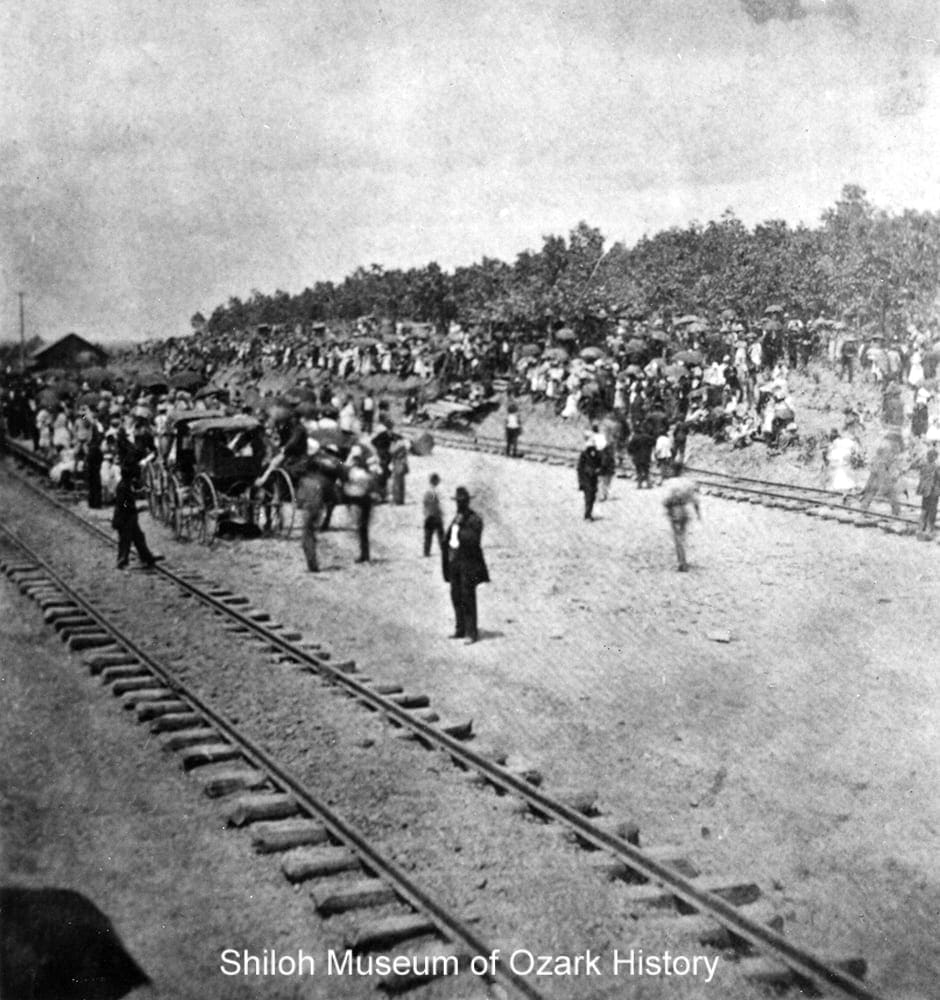
Awaiting the arrival of the first passenger train to Fayetteville, June 8, 1881. Washington County Historical Society Collection (P-1398)
Railroad speculation in Northwest Arkansas began as early as 1860, when a projected line through Benton and Washington Counties was discussed. In the early 1900s there was talk of a line from Fayetteville to Jasper in Newton County but nothing came of it. Today it’s the only Arkansas county to have never had a railroad. Some railroads didn’t accomplish the goals advertised in their names. The closest the Pacific & Great Eastern Railway got to its named destinations was Fayetteville in the west and Wyman, about seven miles east. Placement of railroad lines and depots often fell along practical lines, such as an easier-to-build route or a large population center. But decisions also hinged on bonus arrangements offered by eager communities and businessmen—donations of land, rights of way, and money. For instance, the Frisco built its line through sparsely populated farmland east of the Benton County seat of Bentonville in part because of a donation of land from B. F. Sikes and cash payments of $600 from other residents. As a result, a new town was formed on May 10, 1881, the day the first train arrived. It was named for C. W. Rogers, vice president and general manager of the Frisco.

Awaiting the arrival of the first passenger train to Fayetteville, June 8, 1881. Washington County Historical Society Collection (P-1398)
Railroad Fever
Railroad speculation in Northwest Arkansas began as early as 1860, when a projected line through Benton and Washington Counties was discussed. In the early 1900s there was talk of a line from Fayetteville to Jasper in Newton County but nothing came of it. Today it’s the only Arkansas county to have never had a railroad. Some railroads didn’t accomplish the goals advertised in their names. The closest the Pacific & Great Eastern Railway got to its named destinations was Fayetteville in the west and Wyman, about seven miles east. Placement of railroad lines and depots often fell along practical lines, such as an easier-to-build route or a large population center. But decisions also hinged on bonus arrangements offered by eager communities and businessmen—donations of land, rights of way, and money. For instance, the Frisco built its line through sparsely populated farmland east of the Benton County seat of Bentonville in part because of a donation of land from B. F. Sikes and cash payments of $600 from other residents. As a result, a new town was formed on May 10, 1881, the day the first train arrived. It was named for C. W. Rogers, vice president and general manager of the Frisco.
Who Profited?
In order to be profitable, railroads had to hustle for freight shipments and maintain a steady passenger base. In the 1880s, the area’s emerging canning industry relied on incoming shipments of supplies and equipment, while farmers depended on the cash they received from shipping fresh, canned, and dried produce to market. The railroads helped populate Arkansas by buying or receiving large tracts of land along their routes and then reselling land to farmers and developers, who in turn sold lots to eager transplants. There wouldn’t have been a large-scale timber industry if it hadn’t been for the railroads. They shipped out thousands of carloads of raw lumber and finished products like barrel staves, wood shingles, railroad ties, and mine props (used for holding up underground walls). When the railroad built into Madison County’s rich timberland in the early 1900s, new towns were formed. Along with them came workers and businesses, including saloons and brothels. Through the Railway Post Office citizens received fast, timely delivery of first-class mail, packages, and news publications. In the late 19th century those newspapers carried tales of miraculous (and largely untrue) cures produced by the area’s many mineral springs, leading out-of-state health seekers to board the train and “take the waters” at newly built resorts.
Who Profited?
In order to be profitable, railroads had to hustle for freight shipments and maintain a steady passenger base. In the 1880s, the area’s emerging canning industry relied on incoming shipments of supplies and equipment, while farmers depended on the cash they received from shipping fresh, canned, and dried produce to market. The railroads helped populate Arkansas by buying or receiving large tracts of land along their routes and then reselling land to farmers and developers, who in turn sold lots to eager transplants. There wouldn’t have been a large-scale timber industry if it hadn’t been for the railroads. They shipped out thousands of carloads of raw lumber and finished products like barrel staves, wood shingles, railroad ties, and mine props (used for holding up underground walls). When the railroad built into Madison County’s rich timberland in the early 1900s, new towns were formed. Along with them came workers and businesses, including saloons and brothels. Through the Railway Post Office citizens received fast, timely delivery of first-class mail, packages, and news publications. In the late 19th century those newspapers carried tales of miraculous (and largely untrue) cures produced by the area’s many mineral springs, leading out-of-state health seekers to board the train and “take the waters” at newly built resorts.
Who Suffered?
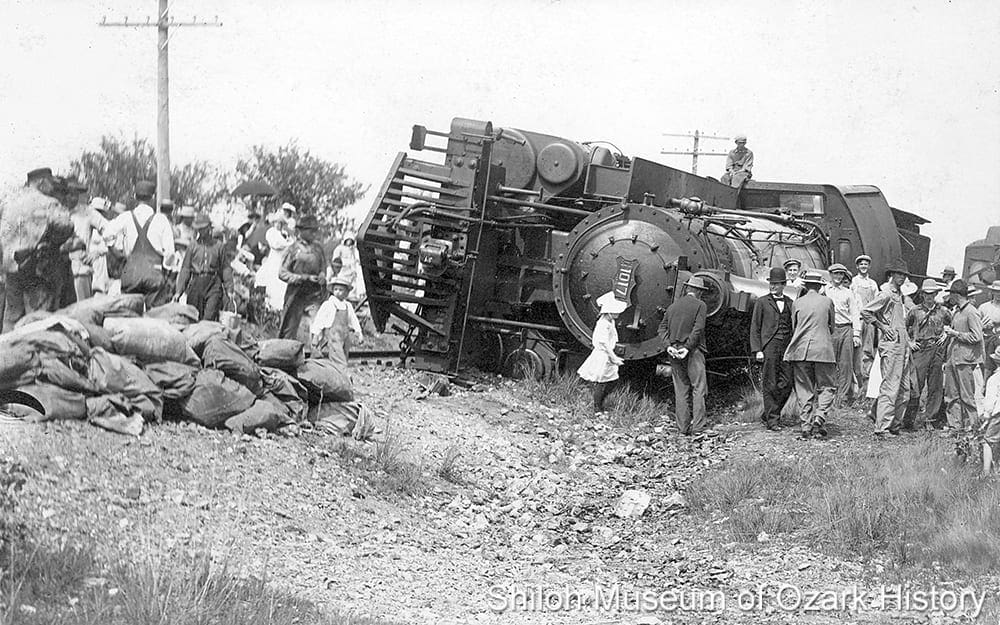
St. Louis & San Francisco wreck, north of Springdale, 1910s. Annabel Applegate Searcy Collection (S-68-19-128)
In the race to build fast and cheap, railroads often used lightweight track or didn’t reduce steep grades (land elevations) or eliminate curves. This led to such problems as roadbed washouts, derailed trains, and the inability to power heavy trains through difficult terrain. Building and operating railroads was dangerous work. In 1902 a gunpowder explosion near Gravette killed two men and badly burned four during construction of the Kansas City, Pittsburg & Gulf Railroad. The following year, the same railroad experienced a head-on collision of two trains near Gentry which killed four, because of poor visibility at a dangerous curve. Financial failure was always a possibility for investors who put their resources in ill-conceived or undercapitalized railroads. Even experienced businessmen suffered. Banker William R. Felker of Rogers built a network of railroads which struggled to succeed. Their failure, and that of his bank, left him a broken man. Landowners along the railroad’s construction path who didn’t want to sell their property faced loss through eminent domain (a legal seizure of property). For African Americans, Arkansas’ “Separate Coach Law” of 1891, proposed by State Senator John Tillman of Fayetteville, led to decades of demeaning travel divided along racial lines as well as substandard train and depot facilities. Like other parts of the South, Northwest Arkansas’ depots had “white only” bathrooms and waiting rooms. The railroads’ appetite for timber for their own construction and as a marketable product contributed to environmental damage through the large-scale clearing of forests, which left thinly soiled mountains unprotected from erosion.

St. Louis & San Francisco wreck, north of Springdale, 1910s. Annabel Applegate Searcy Collection (S-68-19-128)
Who Suffered?
In the race to build fast and cheap, railroads often used lightweight track or didn’t reduce steep grades (land elevations) or eliminate curves. This led to such problems as roadbed washouts, derailed trains, and the inability to power heavy trains through difficult terrain. Building and operating railroads was dangerous work. In 1902 a gunpowder explosion near Gravette killed two men and badly burned four during construction of the Kansas City, Pittsburg & Gulf Railroad. The following year, the same railroad experienced a head-on collision of two trains near Gentry which killed four, because of poor visibility at a dangerous curve. Financial failure was always a possibility for investors who put their resources in ill-conceived or undercapitalized railroads. Even experienced businessmen suffered. Banker William R. Felker of Rogers built a network of railroads which struggled to succeed. Their failure, and that of his bank, left him a broken man. Landowners along the railroad’s construction path who didn’t want to sell their property faced loss through eminent domain (a legal seizure of property). For African Americans, Arkansas’ “Separate Coach Law” of 1891, proposed by State Senator John Tillman of Fayetteville, led to decades of demeaning travel divided along racial lines as well as substandard train and depot facilities. Like other parts of the South, Northwest Arkansas’ depots had “white only” bathrooms and waiting rooms. The railroads’ appetite for timber for their own construction and as a marketable product contributed to environmental damage through the large-scale clearing of forests, which left thinly soiled mountains unprotected from erosion.
End of the Line

Arkansas & Missouri train, Springdale area, January 24, 1992. Charles Bickford, photographer. Springdale News Collection (SN 1-24-1992)
The rise of affordable automobiles and paved roads in the early 1900s, plus the creation of the interstate highway system beginning in the 1950s, allowed travelers to determine their own destinations and schedules. The need for rail transportation faded. Most railroads ended passenger service in the 1960s. Freight traffic suffered, too, as trucks increasingly took to the highways. Unlike trains, which spent time in rail yards while waiting to be shipped out or go through checkpoints, trucks traveled easily point-to-point. Air-shipped freight took its toll too. But railroads have survived. In some ways, today’s smaller, modern railroads fill a specific position, serving unique markets through old-fashioned customer service.

Arkansas & Missouri train, Springdale area, January 24, 1992. Charles Bickford, photographer. Springdale News Collection (SN 1-24-1992)
End of the Line
The rise of affordable automobiles and paved roads in the early 1900s, plus the creation of the interstate highway system beginning in the 1950s, allowed travelers to determine their own destinations and schedules. The need for rail transportation faded. Most railroads ended passenger service in the 1960s. Freight traffic suffered, too, as trucks increasingly took to the highways. Unlike trains, which spent time in rail yards while waiting to be shipped out or go through checkpoints, trucks traveled easily point-to-point. Air-shipped freight took its toll too. But railroads have survived. In some ways, today’s smaller, modern railroads fill a specific position, serving unique markets through old-fashioned customer service.
 Special Thanks
Special Thanks
The Shiloh Museum owes a deep debt of gratitude to Thomas S. Duggan of Lowell. An international banker, railroad historian, long-time museum volunteer, and member of the Arkansas-Boston Mountains Chapter of the National Railway Historical Society, between 2012 and 2014 Tom spent countless hours working on an unpublished manuscript about Northwest Arkansas’ railroads. Much of the information in this exhibit comes from his work.

Special Thanks
The Shiloh Museum owes a deep debt of gratitude to Thomas S. Duggan of Lowell. An international banker, railroad historian, long-time museum volunteer, and member of the Arkansas-Boston Mountains Chapter of the National Railway Historical Society, between 2012 and 2014 Tom spent countless hours working on an unpublished manuscript about Northwest Arkansas’ railroads. Much of the information in this exhibit comes from his work.
Railroads in Northwest Arkansas History
There have been many railroads throughout the history of Northwest Arkansas, resulting in the same set of tracks changing hands—and names—over the years. The following sections are organized by the dominant railroad, and includes info about its predecessor and/or successor railroads.
St. Louis & San Francisco Railway—Fort Smith Subdivision Main Line
In 1880 the St. Louis & San Francisco Railway (Frisco) was prevented from expanding further into Kansas. Seeing Northwest Arkansas’ lumber wealth, the rapid growth of Eureka Springs as a health resort, and Benton County’s then-thriving tobacco industry, the company decided to build south. Work crews entered Benton County during the winter of 1880-1881. Citizens of the future city of Rogers were later rewarded for their land and cash contributions to the railroad with the construction of a roundhouse (for turning around engines) and by the town’s selection as a “freight division” site, a place where train crews changed. Further south the railroad faced huge challenges through the Boston Mountains. A tunnel was blasted through a mountain in Winslow and three long, high, iron trestles (bridges) were built across deep ravines. The work was hard and dangerous. One contractor hired seventy Irishmen and 400 African-Americans from Kansas to build the tunnel, but an outbreak of smallpox killed dozens. While the white men were buried in a cemetery, the Black men were buried in their blankets in mass graves. In 1891 Arkansas’ “Separate Coach Law” required at least one railroad car per race. The senator who proposed the law dividing the races saw its consequences on the day it went into effect. He boarded a Fayetteville train with three cars, two jam-packed with a crowd of 117 whites and one for the two African-Americans on board. The legislation was amended two years later to allow riders of both races in each car, provided there was a physical barrier between them. The law stayed on the books for eighty-two years. Early passengers traveled in all-wood cars heated by coal stoves, lighted by kerosene lamps, and often filled with cigar smoke. The trip from Fayetteville to St. Louis cost a hefty $14. Travelers sometimes experienced train wrecks due to the railroad’s use of lightweight rail. A head-on collision in Lowell in 1897 killed two men and an unidentified tramp. In 1911, two engineers died a few months apart when their respective trains wrecked at the same location in Garfield. During the 1910s the Children’s Aid Society of New York City sent groups of youngsters on so-called “Orphan Trains,” seeking to find homes for them. One group arrived in Rogers in 1912; all were placed with families. Passenger service declined with the rise of the automobile and the airline industry. The last passenger train ran September 1965.
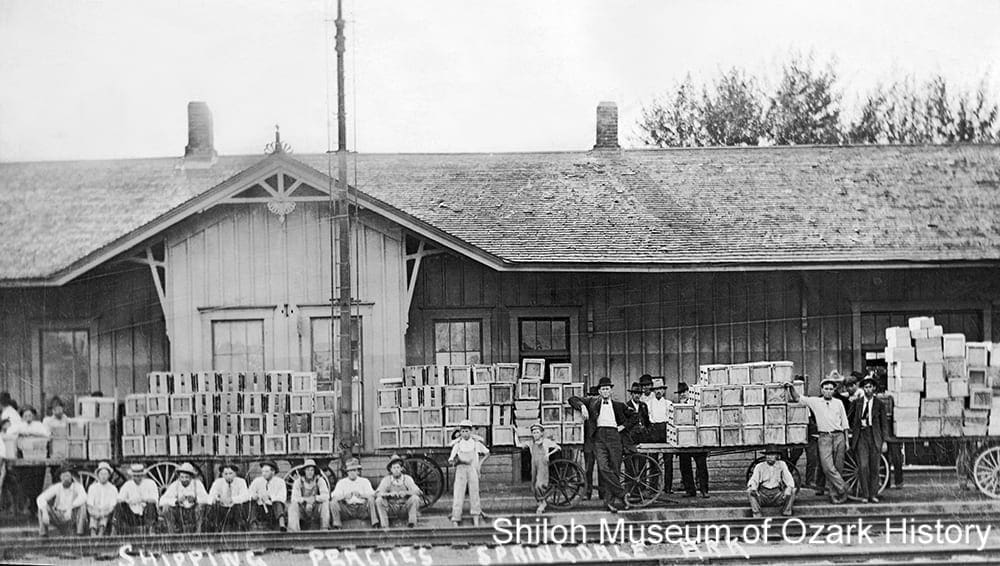
Frisco (Fort Smith Subdivision) peach shipment, Springdale, 1910s. Betty Lou Boyd Collection (S-2001-25-20)
Freight service was the Frisco’s moneymaker. The first shipment of local apples occurred in 1887. As the apple industry ramped up, the Frisco took advantage. It produced the 1904 booklet, Fruit Growing Along the Frisco, to tempt would-be farmers to move to Northwest Arkansas. More apple growers meant more profit for the Frisco. Other crops shipped fresh or canned included peaches, strawberries, grapes, tomatoes, green beans, and spinach. During the 1940s coal trains became a common sight. From the 1950s to the 1970s feed and antibiotics were shipped into the area for the fast-growing poultry industry. Local manufacturers like Heekin Can (Springdale), Baldwin Piano and Organ (Fayetteville), and Daisy Manufacturing (Rogers) shipped in supplies and shipped out finished products. The Burlington Northern Railroad (BN) bought the entire Frisco system in 1980, which, combined with its other holdings, gave it access to industrial markets in the south, allowing Wyoming coal to be shipped through the region to southern coal-fired power plants. With limited local freight, the BN began combining operations. The Rogers and Bentonville agents joined the Springdale agent in a small, steel building. Freight cars were tracked by computer. To save money, the company removed surplus rails and ties and cut back on track maintenance. But when the large railroad couldn’t make a profit from this small segment, it decided to sell. In 1986 the Arkansas & Missouri Railroad (A & M) entered into a lease-sale agreement for the Frisco’s old Fort Smith subdivision, from Monett, Missouri, to Fort Smith, plus the short Bentonville Branch out of Rogers. The BN’s poor maintenance led to several accidents for the new railroad. Freight service continued. Sand from Fort Smith was shipped to Northwest Arkansas to take advantage of the area’s building boom. Aggressive business development combined with personalized service no longer seen within larger railroads got the company close to an operating profit in 1989. Today, improvements such as an extensive track rehabilitation program and the addition of a $2.5 million locomotive repair facility in Springdale helps the railroad remain competitive. Recent shipments include construction materials, corn and soybean meal for poultry, and scrap metal for recycling.
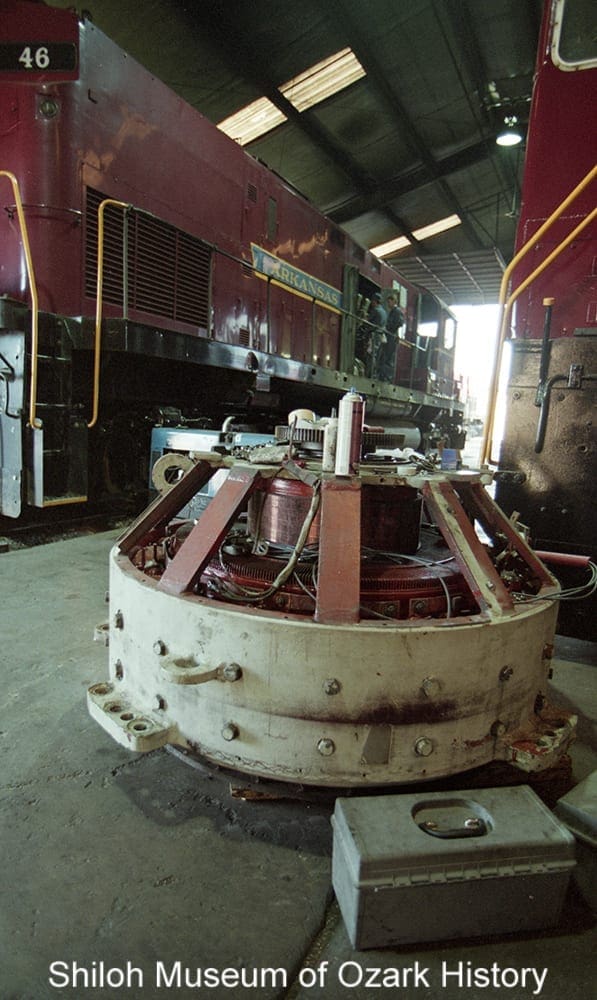
Arkansas & Missouri locomotive repair facility, Springdale, 1999. Charles Bickford, photographer. Springdale News Collection (SN 4-20-1999)
The A & M started an excursion (tourist) business in 1991, offering short trips to places like Van Buren by combining a tourist car with its regular haul of freight. Over the years, antique rail cars were lovingly restored and an 1880s-style wood depot was built in Springdale. While that business ended around 2000, today the A & M once again offers excursion trips. Although the Frisco’s historic depots in Rogers and Springdale were torn down decades ago, Fayetteville’s 1926 southwestern-style depot and outbuildings still stand and have been repurposed as restaurants. The depot was placed on the National Register of Historic Places in 1988. Bricks from the platform of Rogers’ 1912 depot form a small patio next to the Key Wing of the Rogers Historical Museum.
St. Louis & San Francisco Railway—Fort Smith Subdivision Branch Lines
BENTONVILLE BRANCH
After the Frisco chose not to pass through the Benton County seat of Bentonville, a group of businessmen formed the Bentonville Railroad Company to connect the town with Rogers, on the Frisco’s main line. Passenger and freight service began in 1883 from the Bentonville square. To save money, rather than turning the engine around, the twice-daily train ran forwards to Rogers and backwards to Bentonville with the aid of a cowcatcher-equipped caboose, designed to push away stray cattle or other items on the track. But the railroad lost money. It was sold at auction in 1890. All along, Bentonville businessmen wanted a second railroad to force competitive freight rates with the Frisco. In 1889 a group of them formed the Kansas City, Bentonville, & Southeastern Railroad, with the idea of connecting from Missouri to Johnson County, Arkansas, through Bentonville and Springdale. With an estimated cost to the Missouri border of $7,000 per mile, the project began and ended in 1891, after having accomplished a small amount of roadbed construction, some of which traces, in part, a segment of the Rock Trail at Crystal Bridges Museum of American Art in Bentonville. Rogers banker William R. Felker and his partner made Bentonville an offer. In exchange for the existing railroad, land for a right of way, and a sum of money, they would build a railroad west to connect with the Kansas City, Pittsburg & Gulf at Gravette. They formed the Arkansas & Oklahoma Railroad (A & O) in 1898. After repairing the existing railroad’s damaged roadbed, a two-story, brick-and-stone depot was built in Bentonville in 1898 on South Main Street. The new line was built quickly towards Gravette before it turned towards Grove, Oklahoma, in early 1900. From there, passengers had the option of two daily round trips to Rogers and one to Gravette. When Felker’s partner talked about his desire to build further west in order to link with other railroads, the Frisco took note. Rather than risk competition, it bought the A & O in 1900.
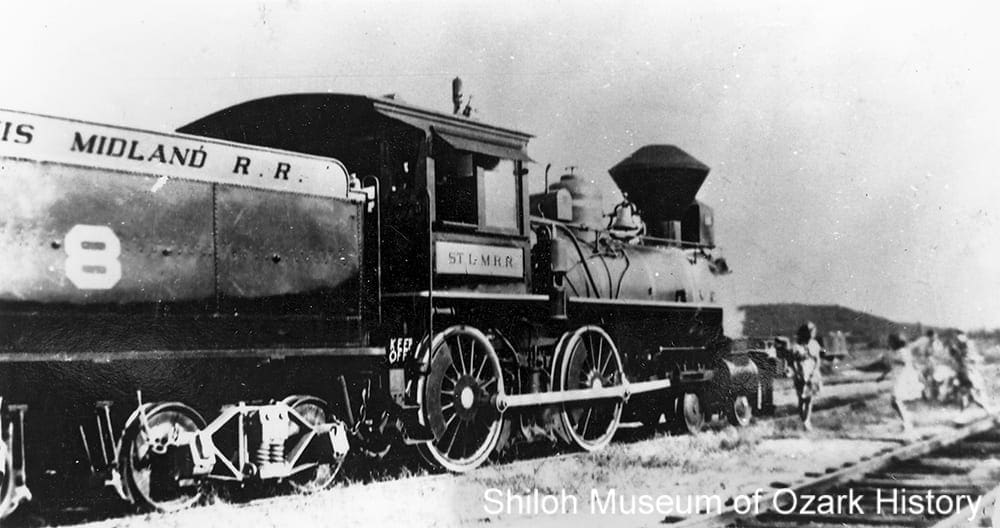
Fictional St. Louis Midland Railroad engine on the Frisco’s Bentonville Branch, Benton County, 1938. Marion E. Bayles Sr. Memorial Collection (S-85-49-25)
In 1900 Mittie M. Lee of Centerton began working for the Frisco’s Bentonville Branch. At the time she was the only female freight and ticket agent in the male-dominated Frisco system. While the railroad had some lumber-related traffic, apples were the money maker. At its peak in 1919, Benton County shipped out five million bushels of apples. Due to a number of factors, by 1928 apple production had dropped off sharply. Still, Hiwasse managed to ship 117 cars of apples while Bentonville shipped 153 cars. In the 1930s the broiler industry was on the rise, but live chickens were hauled to Midwestern processors by truck, not by rail. Seeing little freight traffic, a small portion of track at Hiwasse was turned into the fictional St. Louis Midland Railroad, part of the 1939 movie Jesse James, staring Henry Fonda and Tyrone Power. Dwindling revenues and costly line maintenance led to the 1940 abandonment of 41 miles of track between Bentonville and Grove. By the 1980s the remaining six miles were used by several commercial and industrial customers such as Walmart, but even that use has declined over time. The old Bentonville depot still stands, although greatly modified. For a time it was home to the Bentonville Chamber of Commerce.
MUSKOGEE BRANCH
Between 1885 and 1888 the citizens of Prairie Grove tried (and failed) to build a railroad twelve miles east to Fayetteville. They wanted market access for their produce via the Frisco. A second attempt in 1899 saw the formation of the North Arkansas & Western Railway, made up of organizers from the two towns. Railroad contractor W.A. Bright hired one hundred convicts from the Arkansas State Board of Penitentiary Commissioners to grade the line between Fayetteville and Indian Territory (now Oklahoma). But financial problems meant he couldn’t obtain the needed rails.
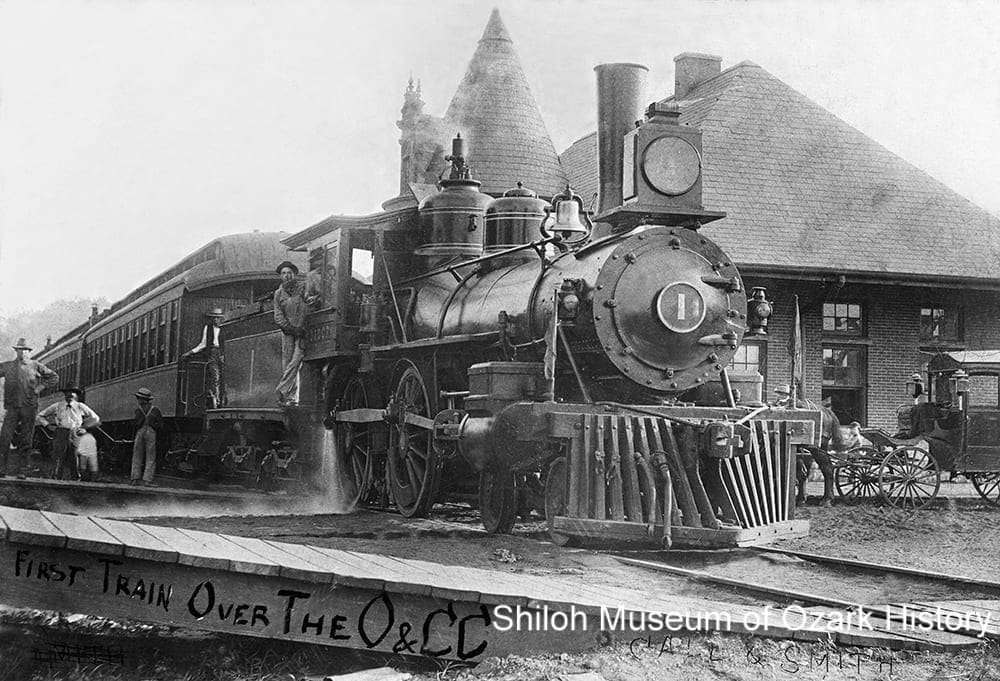
Ozark & Cherokee Central train, Fayetteville, July 1901. Washington County Historical Society Collection (P-4445)
Both Bright and the company’s directors were replaced and the railroad underwent a name change in 1901, becoming the Ozark & Cherokee Central Railway (O & CC). Track was laid and a depot built in Fayetteville. But in 1903 the Frisco worked quietly to purchase the railroad. Investors of the O & CC wondered whether being bought by the debt-heavy Frisco was to their advantage, so they commissioned a study. It found that the railroad’s track was in terrible shape due to poor engineering. Frisco ownership was preferable.
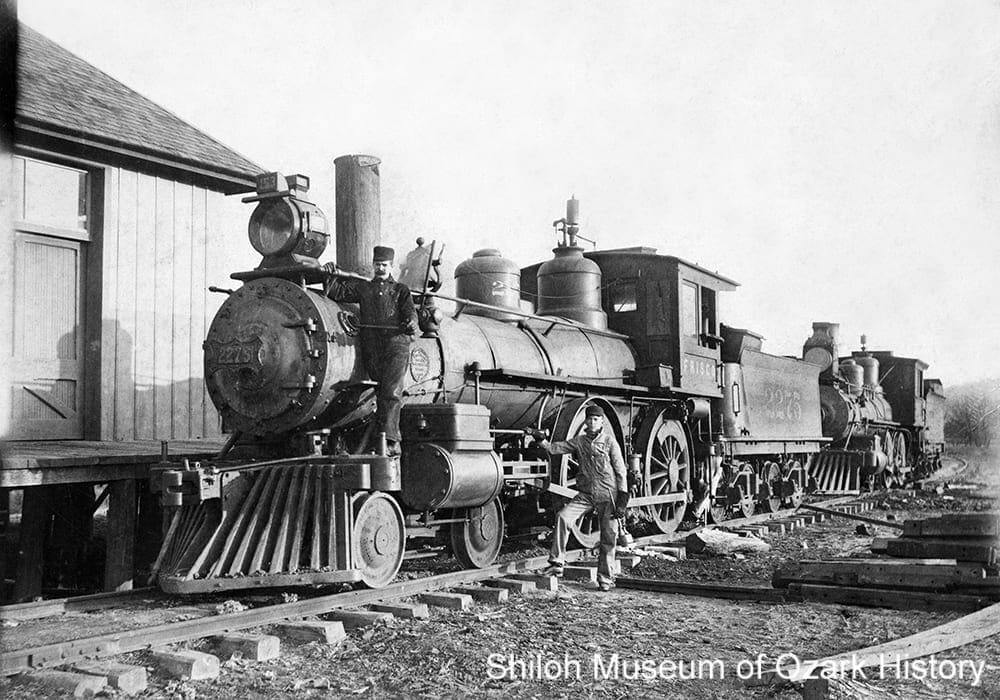
Frisco (Muskogee Branch) train, Washington County, about 1903. Washington County Historical Society Collection (P-4444)
Passenger service on the Frisco’s Muskogee Branch was scheduled to coincide with connections along the Fort Smith Subdivision’s long-distance trains. In 1911 the Frisco purchased several efficient, self-propelled, gasoline-electric cars known as “doodlebugs” to facilitate round-trip passenger service between Fayetteville and Muskogee. In terms of freight, the Oklahoma portion of the line had oil, gas, and crops like corn, oats, and cotton. Western Washington County’s main marketable product was apples, later replaced by strawberries. In 1929 Farmington shipped out 47 railroad cars of apples, 55 of grapes, and 127 of strawberries. The latter had a high value and a short shelf life, lasting only five days. The Frisco’s special berry trains ensured the crop got to market fast in refrigerated cars. In the 1930s both passenger and freight service declined. The line operated at a loss as there were more expenses than revenue. Shortly after the start of World War II, the railroad petitioned to abandon the line. Although some parties objected, the War Production Board decided that the route was not essential. The track was removed in 1942 and transferred to the U.S. Army and Navy to be refashioned into much-needed war materials.
ST. PAUL BRANCH
The Fayetteville & Little Rock Railroad was formed in 1886 by Fayetteville resident Hugh McDanield, a former tie-buyer and experienced railroad builder. The line was built west from Fayette Junction, just south of Fayetteville, into Madison County to St. Paul, where McDanield owned sizable timber holdings. The following year he shipped out a whopping 15,000 railroad cars of mine props and ties valued at $2 million. As it did with other competing railroads, the Frisco purchased the line, effectively owning it by 1887. The final merger didn’t occur until many years later.
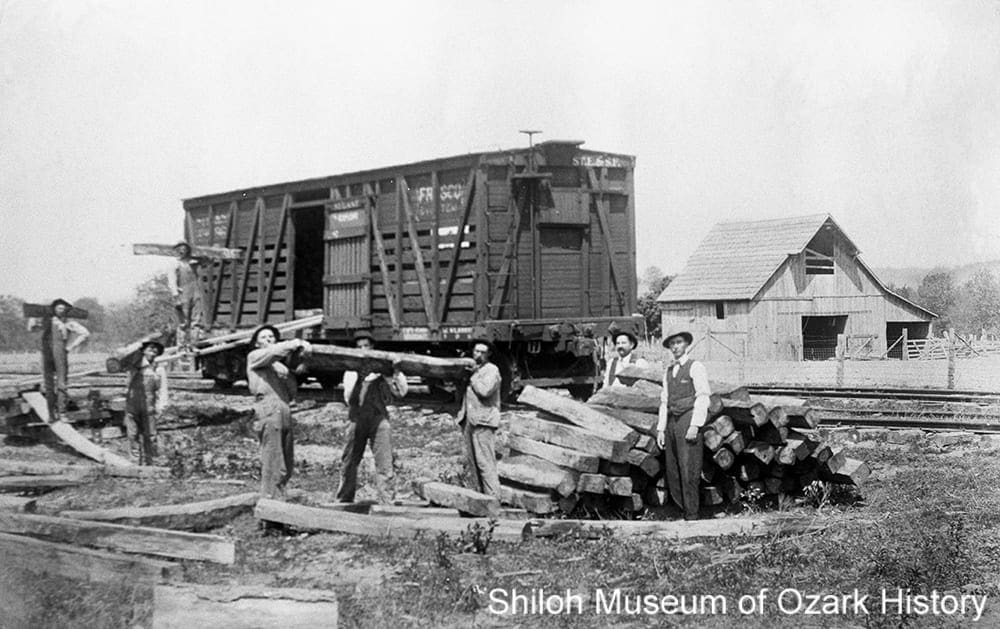
Frisco (St. Paul Branch) tie loading, St. Paul, 1910s. Washington County Historical Society Collection (P-1394)
By 1898 the Frisco’s St. Paul Branch extended to Pettigrew. Boom towns like St. Paul and Pettigrew attracted their fair share of saloons and fights. Longtime St. Paul agent Mattie Williams recalled seeing five to six hundred drunk men fighting in the street on Saturday nights. Conductor John F. Mulrenin had his own way of dealing with unruly lumberjacks. When tempers flared he signaled the engineer to stop the train and forced the men to go outside to settle their differences. Once resolved, they completed their trip. During Madison County’s timber peak, trees were clear cut in large tracts, leaving thinly soiled mountains unprotected from erosion. By 1920 much of the timber was gone. With workers leaving the area, passenger service declined along with freight. One bright spot occurred from 1913 to 1925, when carloads of lumber arrived at Combs for shipment by the Combs, Cass & Eastern Railroad. Poor track maintenance, the arrival of Arkansas Highway 16 in 1929, a slowing industry, and the Great Depression all took its toll. The line was abandoned in 1937.
Combs, Cass & Eastern Railroad
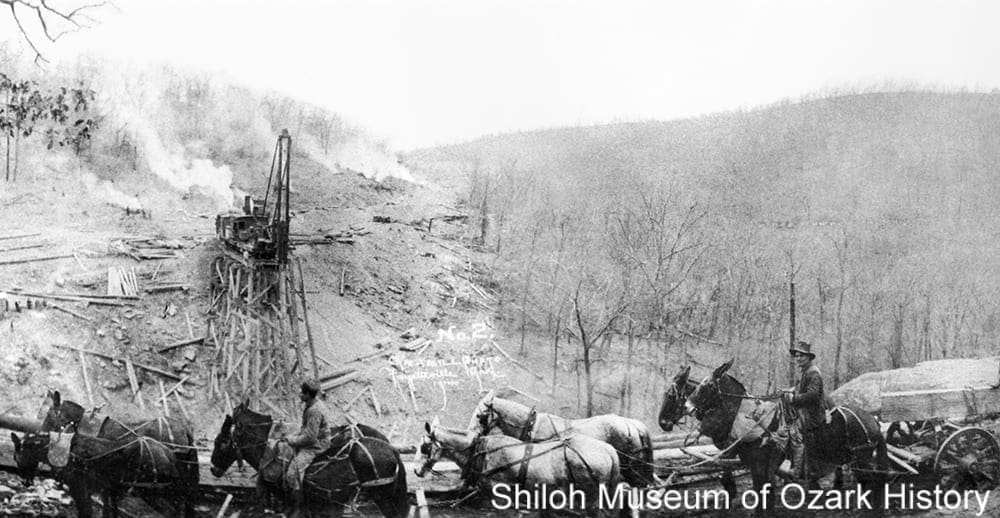
Combs, Cass & Eastern construction of trestle #2, Franklin County, 1914. Burch Grabill, photographer. Winslow Museum Collection (S-2017-23-2)
The Black Mountain & Eastern Railroad was the last line constructed in Northwest Arkansas. Built beginning in 1913 by the J. H. Phipps Lumber Company of Fayetteville, it stretched south from Combs in Madison County into Franklin County, to reach a large stand of old-growth oak. The fine-grained wood was needed for wagon and automobile parts. The line traveled through rugged and rocky terrain, reaching an elevation of 1,900 feet at its highest point. It took tremendous effort to build four large, wood trestles which spanned deep ravines within the Ozark National Forest. At 385 feet in length and 70 feet high, Trestle Four must have seemed pretty scary. When Joy Williams rode the train to attend high school in Cass, she didn’t look down when she was on the trestles. The railroad changed its name to the Combs, Cass & Eastern Railroad in 1916. Later bought by Jay Fulbright, it was never profitable. In 1923 it took in a little over $9,300 worth of freight revenue, not enough to cover its operating expenses. Two years later Fulbright’s son, future U.S. Senator J. William Fulbright, asked permission of the Interstate Commerce Commission to abandon over one half of the line; the rest followed a few years later. By 1928 the railroad was no more.
Kansas City & Memphis Railway
KANSAS CITY & MEMPHIS RAILWAY–WESTERN DIVISION
The Rogers Southwestern Railway was formed in 1904 to build a line between Frisco-served Rogers in eastern Benton County and Kansas City Southern-served Siloam Springs in the west. Principal promoter William R. Felker of Rogers and his business partner thought the proposed route couldn’t lose. Roadbed grading began the following year and moved quickly, with eighteen teams at work at one point. The lightweight track they used meant that extra maintenance would be needed to keep the roadbed from washing out and causing accidents. Although he claimed Siloam Springs as the western end point, Felker kept his options open, looking for the best deal. Siloam Springs and Gentry vied for the line, offering high-dollar awards and rights-of-way; Siloam won.
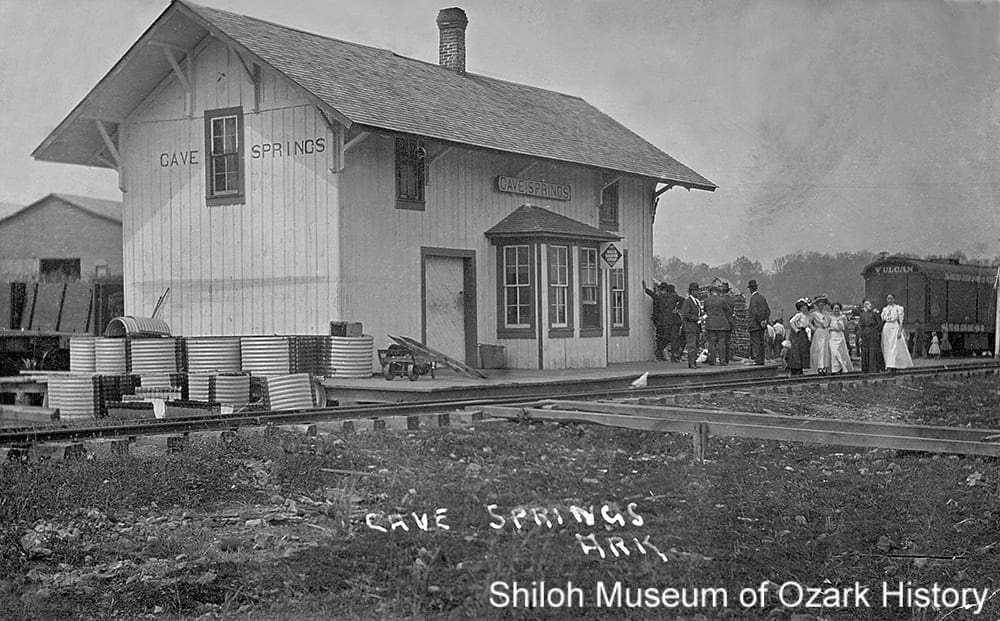
Kansas City & Memphis–Western Division depot, Cave Springs, about 1912. W. Guy Howard Estate (S-71-5-4)
It’s unclear why, but the railroad’s assets were purchased for one dollar in 1907 by the Arkansas, Oklahoma & Western Railroad, which was formed by Felker and his son, John E. Felker. Perhaps the men bought out some of the other investors. It seems the builders took every shortcut possible when constructing the line towards Siloam Springs. Rather than reducing the grade (elevation) when approaching a hill, the builders left it as it was, forcing the train’s engineer to back up several miles to take a run at it, in an effort to climb it by building up a good head of steam. Completed in 1907 and nicknamed the “Fruit Belt Line,” the new railroad gave farmers the ability to ship their produce to market easily. Plus, it gave Rogers businessmen a shipping alternative to the Frisco. In 1910 the line’s name changed to the Kansas City & Memphis Railway. A special electric-battery storage car, designed for lines with light passenger needs, was purchased in 1913. It was pulled out of service the following year. While the car had enough charge to climb the hill at Springtown, its exhausted batteries couldn’t make the trip back. A steam train had to be sent to haul it to Rogers for recharging.
KANSAS CITY & MEMPHIS RAILWAY–EASTERN DIVISION
Developer William Hope “Coin” Harvey worked with the Frisco Railroad in 1902 to build the Monte Ne Railway, a four-mile line from Lowell east to his resort at Monte Ne. Its depot was unique—a large log-and-stone building, much like the resort’s signature hotels. When excursion trains filled with vacationers arrived at the depot, they traveled across the lagoon to their lodging in gondolas imported from Venice. After a few years the resort’s charms dimmed, as folks began traveling by automobile according to their own schedule, not the railroad’s. Built for passengers, the line was more successful in hauling freight like hardwood logs harvested in Madison County and carloads of lime from the Rogers White Lime Company at Cross Hollow. The latter’s president, Fleming F. Freeman, bought the railroad in 1909. Married to William Felker’s daughter, he knew the railroad would fit into his father-in-law’s plans. A year later, Felker began building a short extension west between Lowell and Hazelwood, connecting the eastern division to the western. Between 1912 and 1913 the Ozark Land & Lumber Company extended the line five miles east of Monte Ne, building a bridge over the White River in order to access the timber lands of the late lumber baron, Peter Van Winkle. In 1918 the company shipped 128 cars worth of railroad ties.
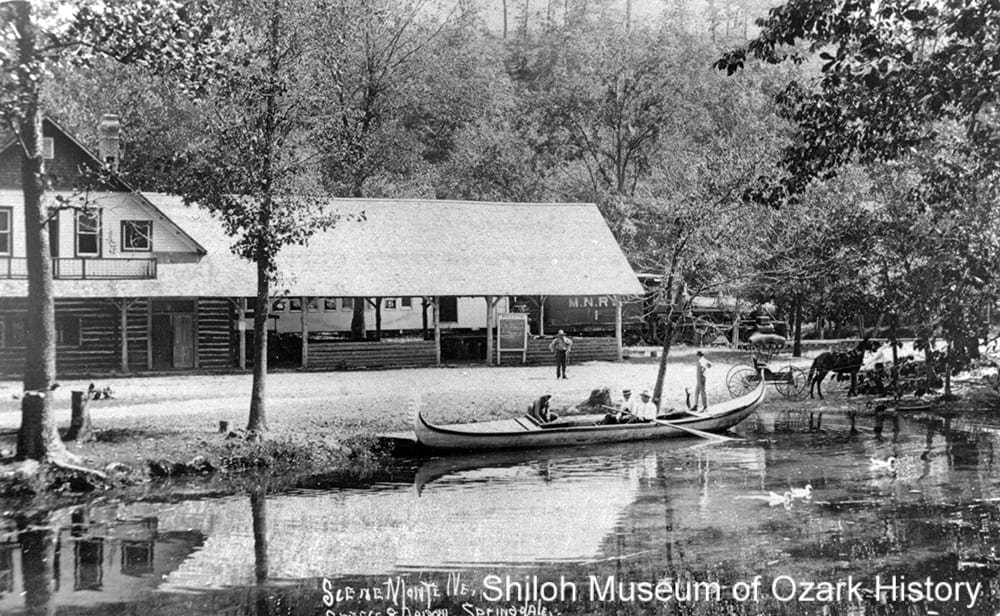
Monte Ne depot, train, and gondola, Monte Ne, about 1908. Speece and Aaron, photographers. Mrs. Kenneth Tillotson Collection (S-90-91-17)
KANSAS CITY & MEMPHIS RAILWAY–MAIN LINE
Felker turned his sights south. In 1910 he began building a route from Cave Springs to the Washington County communities of Tontitown and Elm Springs. His goal was Fayetteville and beyond, despite the Frisco’s dominance. Later that year he changed the names of his various railroads to the Kansas City & Memphis Railroad (KC & M), aiming to build towards Huntsville and Little Rock before heading to Memphis. Fayetteville’s businessmen were all for it, hoping that the competition might cause the Frisco to reduce its freight rates. The Fayetteville Commercial League offered a cash bonus, provided certain conditions were met. Construction began in 1911. The railroad arrived in Fayetteville more than a year later, over budget and behind schedule. There were no speeches or parades, perhaps in consideration of the Frisco, which fought to maintain its monopoly, using whatever legal means it could. During this time the KC & M’s unstable financial structure was exposed. That, combined with larger issues such as the order to ship freight by the shortest possible route during World War I and the state’s mandated low freight rates on certain products, doomed the railroad. Its assets were sold to the highest builder in 1918. Farmers along the line were forced to find other ways to get their crops to market. One young man coming home from World War I found he had to walk to Cave Springs from Rogers because the line was gone.
Kansas City Southern Railway
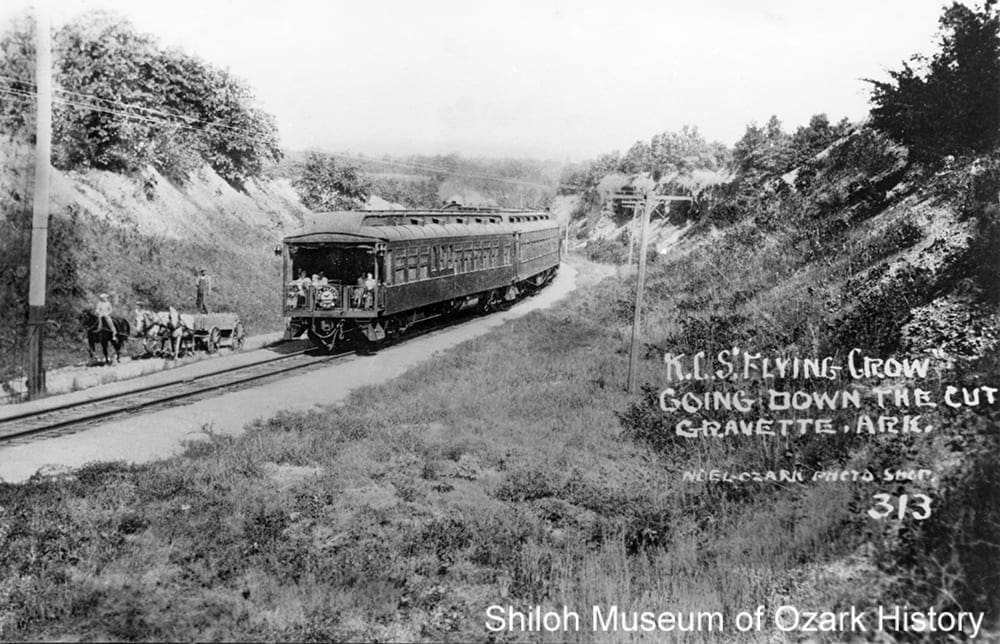
Kansas City Southern “Flying Crow” passenger train, Gravette, early 1900s. Noel-Ozark Photo Shop, photographer. Mrs. Bobbie Kennard Collection (S-86-121-3)
Matthias Splitlog founded the Kansas City, Fort Smith & Southern Railway (KCFS & S) in 1887. A wealthy Native American of Wyandotte ancestry, he became convinced that large deposits of silver and gold could be found in southwest Missouri. Splitlog began building a railroad between Joplin and the town of Splitlog, near the Arkansas border, but lost control of his company. In 1890 new owners pushed on towards Sulphur Springs, causing the Benton County community to consider using its mineral springs to establish a health-based tourism industry. The railroad’s investors considered expanding further south, but instead sold to another investor, who eventually transferred the line to the Kansas City, Pittsburg & Gulf Railroad (KCP & G) in 1893. Arthur Edward Stilwell, the line’s president, was an entrepreneur and land speculator. He extended the Splitlog railroad south to Siloam Springs, which helped establish the apple industry in western Benton County. From there he built through Indian Territory (now Oklahoma) and into Texas. But he underestimated the amount of equipment needed to operate the line. This and industry-wide freight troubles weakened the railroad’s financial strength. A group of investors bought the struggling company in 1900.
Renamed the Kansas City Southern Railway (KCS), one of the company’s early tasks was to address the broken-down condition of the line. Lightweight tracks were replaced, dangerous curves reduced, and powerful steam engines were purchased to move heavy freight through the mountains. The success of the KCS led to the growth of Sulphur Springs in the early 1900s. Hotels, restaurants, and bathhouses were built and large excursion trains brought visitors to town during the health resort’s short-lived period of popularity. Much of the line’s local freight traffic was produce. In 1914 Decatur, which had a population of 500 people, shipped $102,000 worth of blackberries, tomatoes, green beans, strawberries, apples, and other fruits to market. The railroad moved passengers, too. During the 1940s travelers could choose from six passenger trains daily. But dwindling revenues due to changing transportation patterns forced the line to end passenger service in 1969. Years of limited track maintenance led to a multi-car accident at Sulphur Springs in 1972, closing the line for eighty-six hours. Track upgrades took place in time to take advantage of emerging coal shipments from Wyoming. Today the KCS is a well-maintained railroad which hauls commodities to customers in ten states. In Arkansas coal is sent to Simmons Foods’ propane and poultry feed operation in Decatur and to Southwestern Energy & Power Company’s Flint Creek power plant in Gentry.
Arkansas Northwestern Rail Company
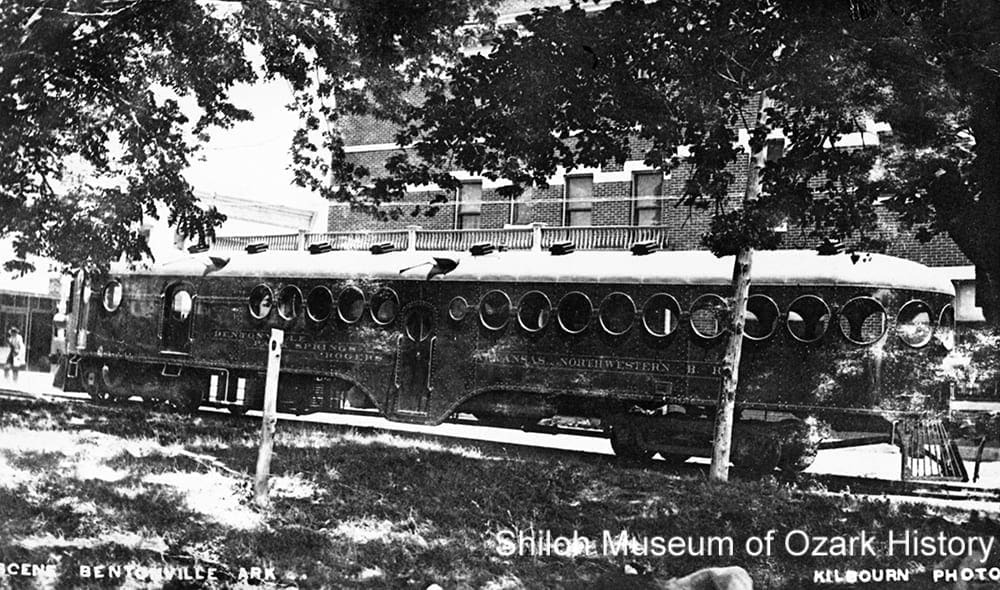
Arkansas Northwestern (Interurban) car near Massey Hotel, Bentonville, 1914–1916. Washington County Historical Society Collection (P-4329)
Several attempts were made to build an interurban transportation system in Benton County to provide low-cost travel between cities in lightly populated urban areas. One proposal finally got off the ground. The Arkansas Northwestern Railroad Company was organized in 1912 with the idea of connecting Pea Ridge, Rogers, Cave Springs, and Springtown. Scaled-back plans focused on Rogers and Bentonville, with a gasoline-powered car traveling partly on the existing tracks of the Frisco’s Bentonville Branch, and partly on tracks laid down the center of city streets. The Bentonville tracks ended at the Park Springs Hotel, a former health resort owned by J.D. Sutherland, who also owned the interurban. Guests coming in by train at Rogers took a thirty-two-minute ride on the interurban to get to the hotel. The car was so powerful that nearly 200 men and a group of musicians travelled to Rogers in 1914 to celebrate the start of service. Reasonable fares meant that locals could easily conduct business between the two towns and attend baseball games, agricultural fairs, and carnivals. But the railroad was short-lived. It folded in 1916 because of failure to pay track-rental charges to the Frisco.
Missouri & North Arkansas Railroad
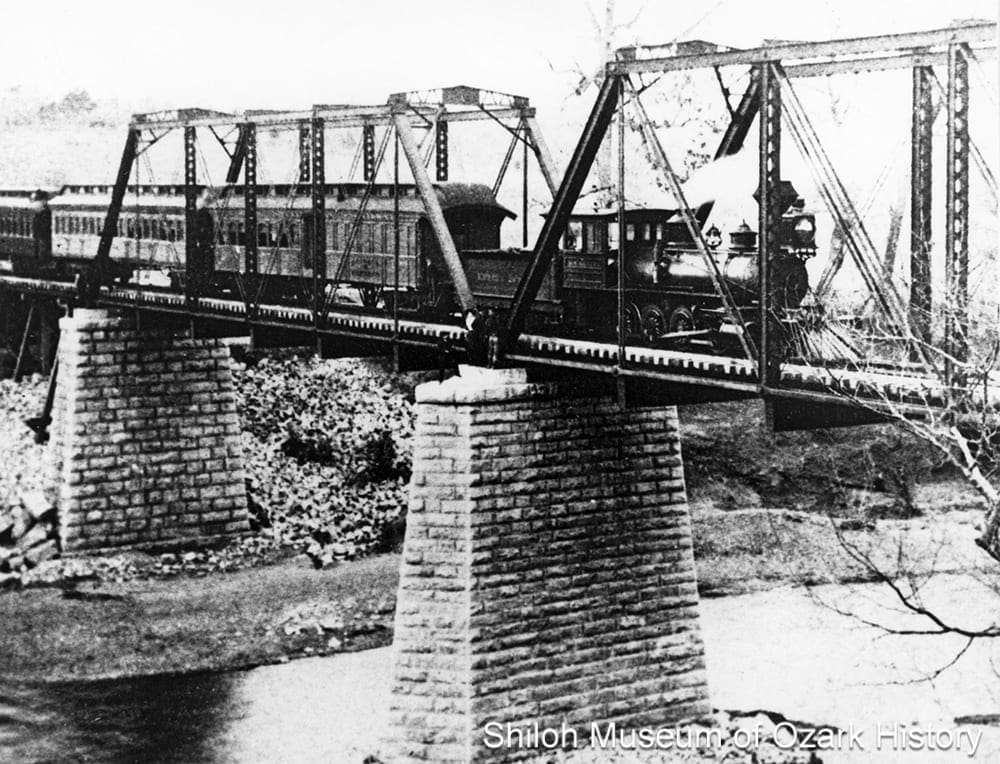
Eureka Springs train crossing the trestle at Beaver, about 1900. F. F. Fyler, photographer. Eureka Springs Library Collection (S-83-325-61)
When the health resort of Eureka Springs was founded in 1879, the nearest railroad stop was Pierce City, Missouri. To get to town, travelers took the “Nine Hour Stage” coach. Former Arkansas Governor Powell Clayton organized the Eureka Springs Railway to construct a line from Seligman, just north of the Arkansas state line. The Frisco owned 20% of the company’s common stock and had a favorable agreement to share freight and passenger revenues. It even offered Pullman sleeping-car service directly from St. Louis. The railroad opened for business in 1883. A few years later it and the Frisco jointly built the majestic 100-room Crescent Hotel, still in operation. The company got in trouble with the Interstate Commerce Commission when it found that the line’s fares were too high and that it charged lower rates for outside shippers than it did for those in town. The railroad began losing money by 1897.
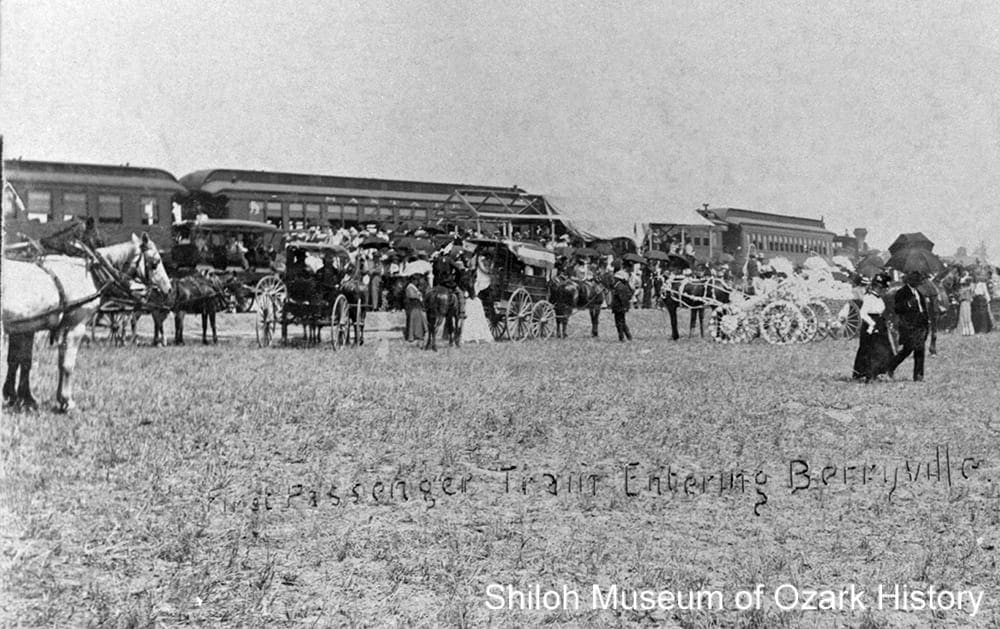
Berryville citizens greeting the first St. Louis & North Arkansas passenger train, June 15, 1901. McCollister, photographer. Carroll County Heritage Center Collection (S-84-211-63)
The line was taken over in 1900 by its St. Louis investors and renamed the St. Louis & North Arkansas Railroad. To increase revenue, they decided to expand east into Boone County to take advantage of nearby marble and zinc deposits. The company began building the new line two miles north of Eureka, making its way to Harrison in 1901, with a short spur line to Berryville. Thrilled by the town’s upcoming railroad-related prosperity, about 2,000 folks attended a celebration welcoming the first train. The line soon continued sixty miles east to Searcy County to connect with a major manufacturer of wood barrels. Ultimately the railroad was unsuccessful. The track’s many curves and steep grades meant that its trains had to run slowly and use more power, making the line expensive to run. There also wasn’t enough freight traffic to operate profitably. Headquartered in Harrison, the newly chartered Missouri & North Arkansas Railroad (M & NA) took over in 1906. It transformed itself into a “bridge carrier,” a railroad which took freight from one railroad and transported it to another. It also tried to encourage long-distance passenger service by putting out the booklet, Heart of the Ozarks, claiming “The air of the Ozarks is a life-giving blend of distilled sunbeams and of the healing oils and odors of the piney woods.” Even though freight traffic increased in 1910, the railroad lost money. It was dealt a further blow in 1918 when it came under control of the United States Railroad Administration (USRA). The agency was created during World War I to oversee those railroads deemed necessary for the war effort. When the M & NA couldn’t pay its union employees a higher wage as required by USRA, USRA paid it during the war’s duration. When the line lost its monetary assistance, it reduced wages by twenty percent. Harrison’s railroad workers went on strike in 1921. They had the town’s support, at first, but that changed with higher transport costs and upon learning that the strikers had turned violent, burning trestles and cutting air-brake hoses on railroad cars. The union’s national leaders were run out of town. Tensions and violence continued into 1923 when a union shop worker was forcibly taken from jail and hanged from a trestle. Fearing for themselves and their families, many railroad employees left. The strike was over. Continued financial problems and the Great Depression led to the railroad’s end. It was bought by Frank Kell in 1935 and renamed the Missouri & Arkansas Railway. Poorly maintained track, high operating expenses, and frequent annual losses continued to sap the line’s finances. It didn’t help that the Kell family took company profits and salaries that could have been used towards track repair. A major washout in 1945 isolated a huge stretch of track for several months. When the employees went on strike for higher wages, the Kells sold the line. It was not in operation from 1946 through 1949.
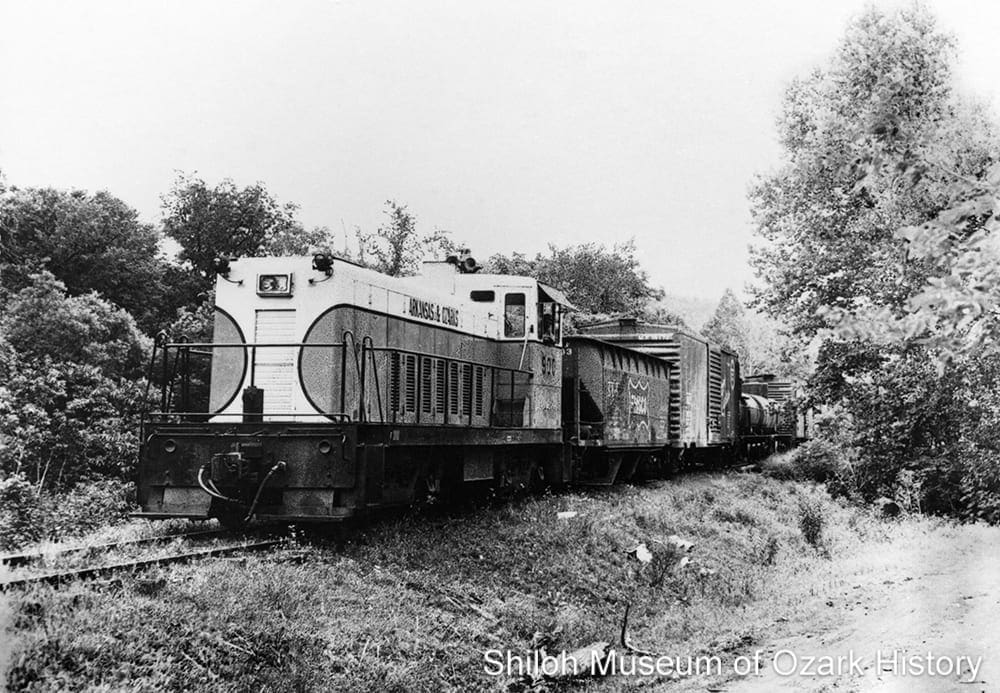
Arkansas & Ozarks freight train, Beaver, about 1960. Carroll County Heritage Center Collection (S-84-211-105)
But hope springs eternal. The Arkansas & Ozarks Railway was organized in 1949. It abandoned much of the line, retaining the Seligman-to-Harrison segment with service to Eureka Springs and Berryville. Track improvements were made and freight business picked up. Harrison shipped out barrel staves and railroad ties; Eureka shipped out Ozarka spring water in glass-lined tanks. Still, the railroad’s annual deficits grew. In 1960 a flash flood near Eureka caused miles of track damage. The trouble-plagued line was finally abandoned the following year.
Missouri Pacific Railroad
The main line of the St. Louis, Iron Mountain & Southern Railway ran diagonally through Arkansas, from St. Louis to Little Rock to Texarkana and into Texas. Between 1902 and 1905 it built the White River Division, a branch line from Branson, Missouri, which ran across the northeast corner of Boone County before heading to Newport, Arkansas. Builders made a deep “cut” (passage) through a mountainous area west of Bergman. It also built an expensive tunnel through Omaha and a large trestle across the Wooded Hills valley, where one of the workers fell to his death. Farmers and merchants benefitted from the railroad. Cedar posts, crossties, and stave bolts for making barrels were shipped out of Bergman, along with cotton brought over from Lead Hill. One of the line’s most productive stops for a time was Zinc, home to zinc ore. With two passenger and two freight trains daily, some Bergman residents spent part of their Sunday afternoons at the depot, watching the activity. There was some talk over the years of building a line between Harrison, served by the Missouri & North Arkansas, and the Iron Mountain line, but nothing came of it. By 1917 the entire Iron Mountain system was absorbed by the Missouri Pacific Railroad. The African-Americans who worked on the railroad often made better money than they would have in other jobs, but they still faced discrimination. When Black workers stayed in the Cricket area, they lived in bunk cars parked on a side track; they weren’t allowed to wander in the community. John Parton grew up in Cricket and remembered going with his family to a bluff to watch the men, saying that some of them gambled and drank while others sang and worshipped. The last passenger train came through in 1960, the same year mail service ended. Both losses took a toll on the line. The company merged with the Union Pacific Railroad in 1982. Ten years later the line was bought by the Missouri & Northern Arkansas Railroad. Today it ships commodities like coal, steel, asphalt, and grain, and it services the area’s growing poultry industry. The Branson Scenic Railway offers excursion trains out of Branson, sometimes traveling across the Arkansas state line into Bergman.
Pacific and Great Eastern Railway
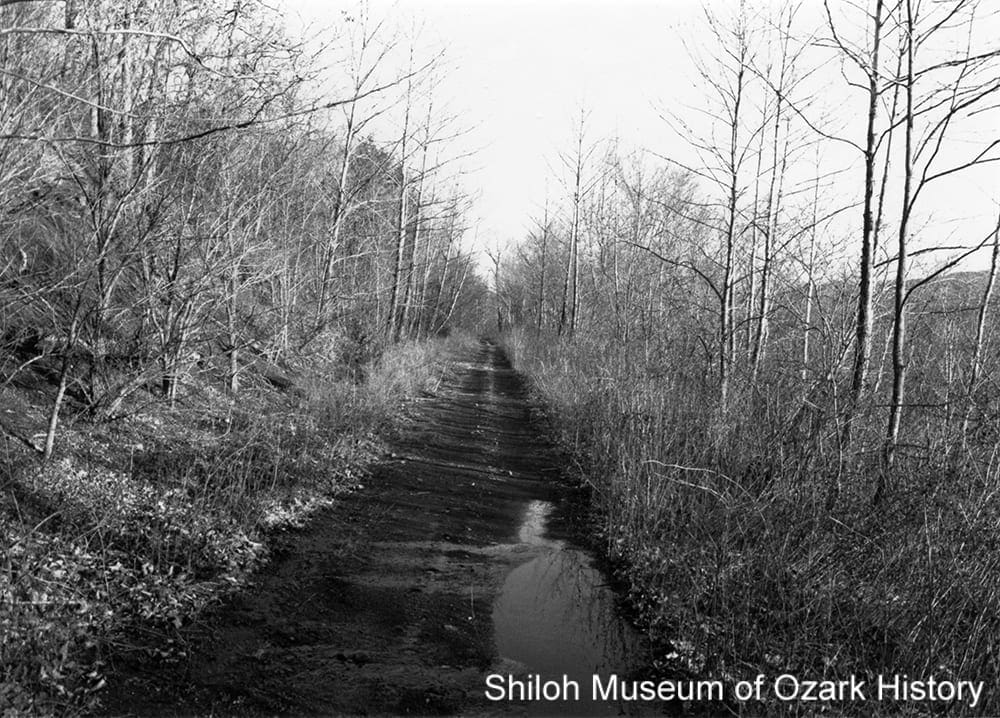
Pacific & Great Eastern former roadbed, Buckner, November 1990. Chris Lord, photographer. Chris Lord Collection (S-90-178-6)
With railroad fever in the air, in 1884 an Arkansas company announced plans to build the Pacific & Great Eastern Railway from northern Arkansas west to Cincinnati on Washington County’s western border. They made a bold promise to complete the 350-mile long route within seven years. It took some doing, but Fayetteville investors raised $25,000 to build a roundhouse and fifteen miles of track from Fayetteville east to the Madison County line. But the line only got as far as Wyman, about seven miles away. Male-only “swim trains” during the summer brought passengers to the White River, but because there was no way to turn the train around, it ran backwards on the return trip to Fayetteville. Never profitable, the line existed for only a few years.
Tourist Railroads
BOSTON MOUNTAIN RAILROAD EXCURSION COMPANY
In 1990 the Boston Mountain Railroad Excursion Company used the tracks of the Arkansas & Missouri Railroad (A & M) to offer sightseers a chance to ride the rails between Rogers and Van Buren and later Exeter, Missouri. The A & M’s locomotives pulled the company’s antique cars, one of which offered lunch service. Members of the Boston Mountains Chapter (Springdale) of the National Railway Historical Society served as hosts. The operation ended in 1992 when the A & M determined that the passenger cars did not meet standards for safe operation. The cars found a new home on the White River Scenic Railway, based in Flippin, Arkansas.
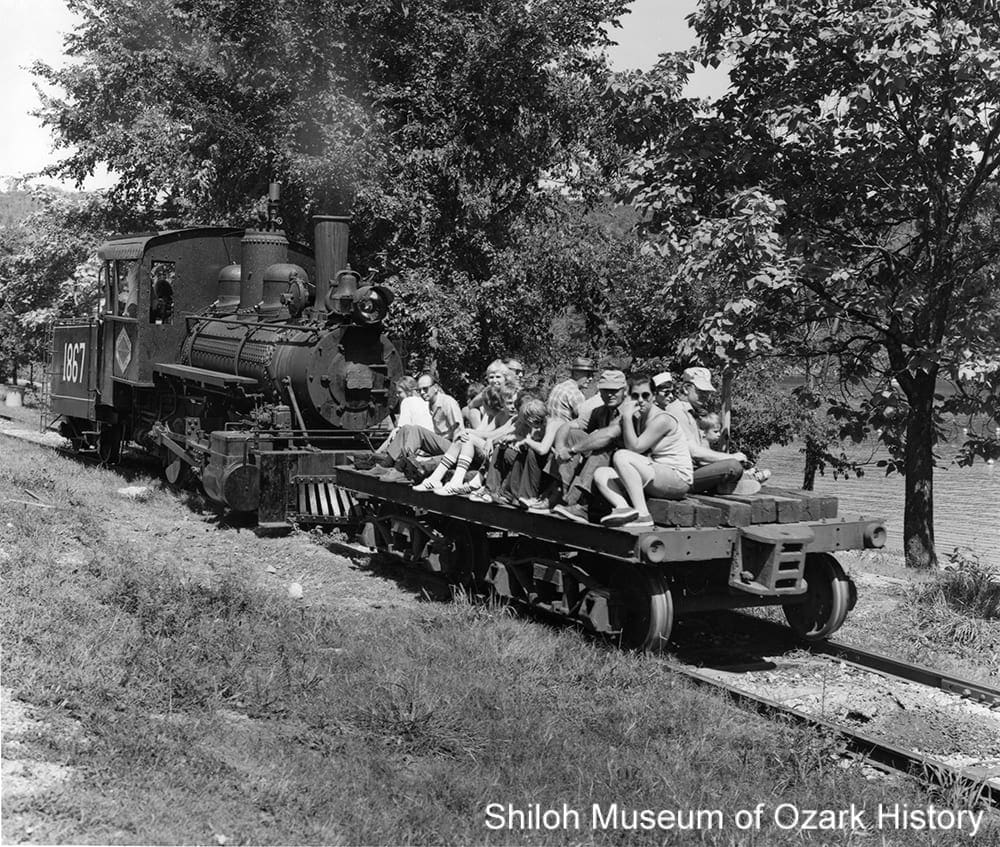
Eureka Springs Railroad tourists, near Beaver, 1974. Larry L. Logan, photographer. Frances Deane Alexander Collection (S-2012-137-39)
EUREKA SPRINGS RAILROAD
Brothers and railroad historians Reat and Dreat Younger formed the Eureka Springs Railroad in the 1970s. Located near Eureka Springs in Beaver, it featured two steam engines, a museum, and a rebuilt steel bridge once used over the White River at Missouri’s Table Rock Lake. It operated for short periods in the late 1970s and early 1980s, with a full tourist season in 1982. That same year it was featured in the Civil War television mini-series, The Blue and the Gray. The railroad ended operations in 1985 following significant flood damage to its tracks and bridge. Two years later the equipment was sold to the Krazy Horse Ranch near Branson. The museum is now part of the Boone County Historical Society.
EUREKA SPRINGS & NORTH ARKANSAS RAILWAY
The Robert Dortch Jr. family began operating the Eureka Springs & North Arkansas Railway in 1981, after moving equipment from their south Arkansas cotton plantation to Eureka Springs. The tourist line operates on the old roadbed of the Arkansas & Ozarks Railroad and uses the grand stone depot built by the Missouri & North Arkansas Railroad in 1912–1913 for its ticketing operations. Steam engines were used at first, but because their boilers require expensive rebuilding, the vintage passenger cars are now pulled by a 1948 diesel engine. In 1989 the railway began an excursion business in Fayetteville. It hauled its antique railroad cars by truck to Springdale to use the A & M’s tracks and locomotive. While that business failed, the line still operates out of Eureka, offering sightseeing and dining options.
Map of Northwest Arkansas Railroads Through the Years
View an enlarged version of the map below, complete with a color-coded key of railroads. (This is a large pdf document.)
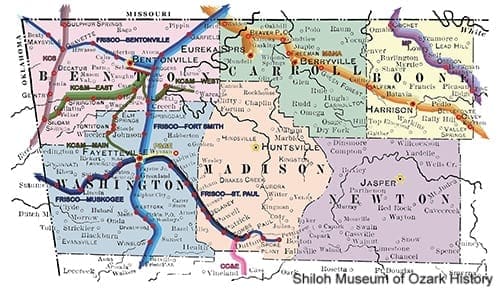
Want to Know More?
Visit our Transportation Podcasts page to hear local railroad historian Mike Sypult’s talks on “Railroad Disasters in Northwest Arkansas” and “The Peavine Railway.”

